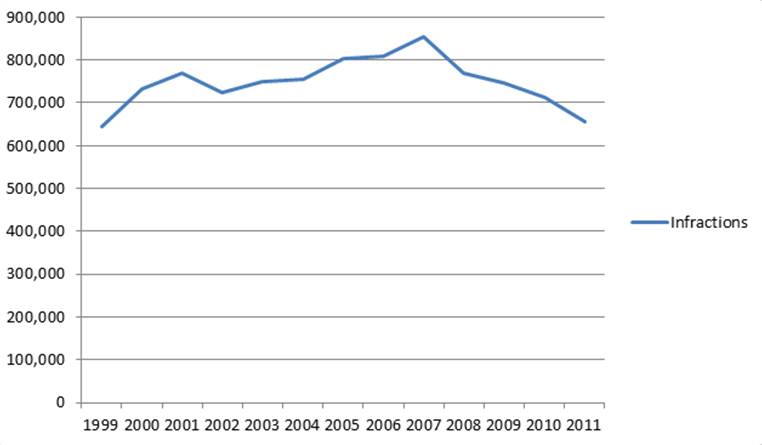Court Costs and Traffic Citations
Published for NC Criminal Law on October 31, 2012.
Court costs support many different programs and purposes. The principal statute concerning court costs in criminal cases is G.S. 7A-304. (Under G.S. 15A-1118, these costs also apply to infraction cases.) G.S. 7A-304 establishes various court costs for the support of “courtroom(s) and related judicial facilities,” “courthouse phone systems,” “retirement and insurance benefits [for] . . . law-enforcement officers,” “operations of the Criminal Justice [and Sheriffs’]” training and standards commissions, “pretrial release services,” general support of the court system, and so on.
The state’s budget has been very tight in recent years, and the General Assembly has repeatedly increased existing court costs and created new ones. This AOC document summarizes current court costs. I’d like to focus on the costs associated with traffic infractions, for reasons that will become clear in a moment. Those costs currently total $188 for most cases. (They’re similar for other district court matters, and considerably higher for cases that move to superior court.) To put this in historical perspective, on July 1, 2011, motor vehicle infractions carried costs of $170. As of October 1, 2010, costs were $141. As of September 1, 2009, they were $130. As of July 20, 2008, they were $121. A year earlier, they were $120.
Of course, the true cost to a typical motorist of being cited for an infraction is not limited to court costs. The driver may also pay a lawyer, may miss time from work to attend court, may pay a fine, and may face higher insurance costs.
I heard recently that the number of traffic cases filed has decreased, which has been difficult for some of the organizations supported by criminal court costs. The chart below, based on AOC data, confirms the decline in infraction cases filed. (The vast majority of infraction cases involve motor vehicle offenses.)
 One possible explanation for the decline is that some officers are reluctant to issue citations knowing that court costs are so high. In other words, some officers may be issuing more warnings and fewer citations based on a feeling that the cost of a citation has gotten out of proportion to the seriousness of a typical moving violation. There is, in fact, a temporal correlation between the run-up in court costs and the decline in infraction cases. However, correlation does not prove causation, and there are other possible explanations.
Drivers could be committing fewer offenses, either because they are driving less or because they are driving more carefully. I doubt that this is the case, however. Traffic volume has been about the same since 2009, according to the United States Department of Transportation, so people are not driving less. I suppose that it is possible that people are driving more carefully, but I haven’t noticed that in my time on the roads.
Officers could be detecting fewer offenses, perhaps because law enforcement agencies, faced with limited budgets, are doing less traffic enforcement. This strikes me as a more plausible explanation, supported somewhat by the fact that criminal motor vehicle case filings are also down, from a bit over 1.1 million in FY2010-11 to a bit under 1 million in FY2011-12. I doubt that many officers would choose to forego a criminal traffic violation out of concern for court costs, since criminal violations are typically more serious than infractions. The decline in filings of this type therefore suggests that officers may simply be detecting fewer violations.
Officers could be writing fewer citations for some other reason besides higher costs. For example, if the paperwork associated with writing a citation had recently become much more cumbersome, officers might be writing fewer citations to avoid the drudgery, or because so many hours were spent pushing paper and not enforcing the law. I’m not aware of any change of that nature, however.
Readers, what do you make of this data? Are there explanations that I’m missing? Officers, has the rise in court costs made you more hesitant to issue a citation?
As a final note, the data presented above don’t reach the separate question of whether judges are waiving costs more often as they have risen. That’s also an interesting question, but it will have to wait for a future post.
One possible explanation for the decline is that some officers are reluctant to issue citations knowing that court costs are so high. In other words, some officers may be issuing more warnings and fewer citations based on a feeling that the cost of a citation has gotten out of proportion to the seriousness of a typical moving violation. There is, in fact, a temporal correlation between the run-up in court costs and the decline in infraction cases. However, correlation does not prove causation, and there are other possible explanations.
Drivers could be committing fewer offenses, either because they are driving less or because they are driving more carefully. I doubt that this is the case, however. Traffic volume has been about the same since 2009, according to the United States Department of Transportation, so people are not driving less. I suppose that it is possible that people are driving more carefully, but I haven’t noticed that in my time on the roads.
Officers could be detecting fewer offenses, perhaps because law enforcement agencies, faced with limited budgets, are doing less traffic enforcement. This strikes me as a more plausible explanation, supported somewhat by the fact that criminal motor vehicle case filings are also down, from a bit over 1.1 million in FY2010-11 to a bit under 1 million in FY2011-12. I doubt that many officers would choose to forego a criminal traffic violation out of concern for court costs, since criminal violations are typically more serious than infractions. The decline in filings of this type therefore suggests that officers may simply be detecting fewer violations.
Officers could be writing fewer citations for some other reason besides higher costs. For example, if the paperwork associated with writing a citation had recently become much more cumbersome, officers might be writing fewer citations to avoid the drudgery, or because so many hours were spent pushing paper and not enforcing the law. I’m not aware of any change of that nature, however.
Readers, what do you make of this data? Are there explanations that I’m missing? Officers, has the rise in court costs made you more hesitant to issue a citation?
As a final note, the data presented above don’t reach the separate question of whether judges are waiving costs more often as they have risen. That’s also an interesting question, but it will have to wait for a future post.
 One possible explanation for the decline is that some officers are reluctant to issue citations knowing that court costs are so high. In other words, some officers may be issuing more warnings and fewer citations based on a feeling that the cost of a citation has gotten out of proportion to the seriousness of a typical moving violation. There is, in fact, a temporal correlation between the run-up in court costs and the decline in infraction cases. However, correlation does not prove causation, and there are other possible explanations.
Drivers could be committing fewer offenses, either because they are driving less or because they are driving more carefully. I doubt that this is the case, however. Traffic volume has been about the same since 2009, according to the United States Department of Transportation, so people are not driving less. I suppose that it is possible that people are driving more carefully, but I haven’t noticed that in my time on the roads.
Officers could be detecting fewer offenses, perhaps because law enforcement agencies, faced with limited budgets, are doing less traffic enforcement. This strikes me as a more plausible explanation, supported somewhat by the fact that criminal motor vehicle case filings are also down, from a bit over 1.1 million in FY2010-11 to a bit under 1 million in FY2011-12. I doubt that many officers would choose to forego a criminal traffic violation out of concern for court costs, since criminal violations are typically more serious than infractions. The decline in filings of this type therefore suggests that officers may simply be detecting fewer violations.
Officers could be writing fewer citations for some other reason besides higher costs. For example, if the paperwork associated with writing a citation had recently become much more cumbersome, officers might be writing fewer citations to avoid the drudgery, or because so many hours were spent pushing paper and not enforcing the law. I’m not aware of any change of that nature, however.
Readers, what do you make of this data? Are there explanations that I’m missing? Officers, has the rise in court costs made you more hesitant to issue a citation?
As a final note, the data presented above don’t reach the separate question of whether judges are waiving costs more often as they have risen. That’s also an interesting question, but it will have to wait for a future post.
One possible explanation for the decline is that some officers are reluctant to issue citations knowing that court costs are so high. In other words, some officers may be issuing more warnings and fewer citations based on a feeling that the cost of a citation has gotten out of proportion to the seriousness of a typical moving violation. There is, in fact, a temporal correlation between the run-up in court costs and the decline in infraction cases. However, correlation does not prove causation, and there are other possible explanations.
Drivers could be committing fewer offenses, either because they are driving less or because they are driving more carefully. I doubt that this is the case, however. Traffic volume has been about the same since 2009, according to the United States Department of Transportation, so people are not driving less. I suppose that it is possible that people are driving more carefully, but I haven’t noticed that in my time on the roads.
Officers could be detecting fewer offenses, perhaps because law enforcement agencies, faced with limited budgets, are doing less traffic enforcement. This strikes me as a more plausible explanation, supported somewhat by the fact that criminal motor vehicle case filings are also down, from a bit over 1.1 million in FY2010-11 to a bit under 1 million in FY2011-12. I doubt that many officers would choose to forego a criminal traffic violation out of concern for court costs, since criminal violations are typically more serious than infractions. The decline in filings of this type therefore suggests that officers may simply be detecting fewer violations.
Officers could be writing fewer citations for some other reason besides higher costs. For example, if the paperwork associated with writing a citation had recently become much more cumbersome, officers might be writing fewer citations to avoid the drudgery, or because so many hours were spent pushing paper and not enforcing the law. I’m not aware of any change of that nature, however.
Readers, what do you make of this data? Are there explanations that I’m missing? Officers, has the rise in court costs made you more hesitant to issue a citation?
As a final note, the data presented above don’t reach the separate question of whether judges are waiving costs more often as they have risen. That’s also an interesting question, but it will have to wait for a future post.Public Officials - Courts and Judicial Administration Roles
Topics - Courts and Judicial Administration



